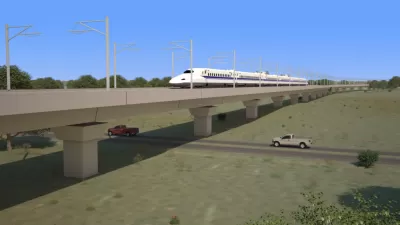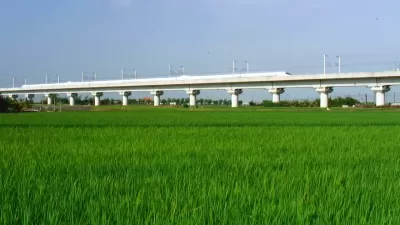The Dallas Business Journal provides in depth coverage on the current planning efforts behind two proposed high-speed rail station locations in Dallas.
"Two preferred sites for a potential new Dallas high-speed rail station are going through environmental impact studies, which could bring a rail station and billions of dollars in surrounding development to downtown Dallas," reports Candice Carlisle.
Carlisle reports on the proposed sites from the development side of the proposed station. Carlisle quotes Matthews Southwest President Jack Matthews (elected as the development partner on the station and the surrounding development) saying that the station and the resulting development would "a massive game changer."
Nicholas Sakeleris also reports on the announcement by drilling down on the details of the proposed sites.
"One site is 10 to 20 acres of undeveloped land west of Lamar Street that could accommodate the high-speed rail station, parking and space for future transit-oriented development. It's located west of Gilley's Dallas and the NYLO Dallas Hotel on the other side of the existing freight tracks. The bullet train would use its own tracks with overhead power lines passing through a tight-40-foot right-of-way corridor."
"A second proposed site would extend over Interstate 30 and includes a portion of the first candidate site and would be adjacent to the Dallas Convention Center."
Sakeleris also includes more detail about the Texas Central Railway's intentions for the station to become an iconic symbol of Dallas, as well as its potential to drive new development in the area and connect with the existing Dallas Area Rapid Transit System.
FULL STORY: Jack Matthews: Dallas high-speed rail station to be 'massive game-changer'

Study: Maui’s Plan to Convert Vacation Rentals to Long-Term Housing Could Cause Nearly $1 Billion Economic Loss
The plan would reduce visitor accommodation by 25,% resulting in 1,900 jobs lost.

North Texas Transit Leaders Tout Benefits of TOD for Growing Region
At a summit focused on transit-oriented development, policymakers discussed how North Texas’ expanded light rail system can serve as a tool for economic growth.

Why Should We Subsidize Public Transportation?
Many public transit agencies face financial stress due to rising costs, declining fare revenue, and declining subsidies. Transit advocates must provide a strong business case for increasing public transit funding.

How to Make US Trains Faster
Changes to boarding platforms and a switch to electric trains could improve U.S. passenger rail service without the added cost of high-speed rail.

Columbia’s Revitalized ‘Loop’ Is a Hub for Local Entrepreneurs
A focus on small businesses is helping a commercial corridor in Columbia, Missouri thrive.

Invasive Insect Threatens Minnesota’s Ash Forests
The Emerald Ash Borer is a rapidly spreading invasive pest threatening Minnesota’s ash trees, and homeowners are encouraged to plant diverse replacement species, avoid moving ash firewood, and monitor for signs of infestation.
Urban Design for Planners 1: Software Tools
This six-course series explores essential urban design concepts using open source software and equips planners with the tools they need to participate fully in the urban design process.
Planning for Universal Design
Learn the tools for implementing Universal Design in planning regulations.
City of Santa Clarita
Ascent Environmental
Institute for Housing and Urban Development Studies (IHS)
City of Grandview
Harvard GSD Executive Education
Toledo-Lucas County Plan Commissions
Salt Lake City
NYU Wagner Graduate School of Public Service




























